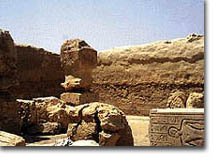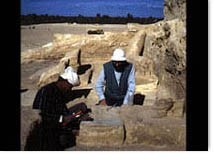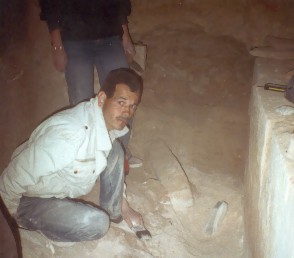
Between 1992 and 1994 the University of Pisa made remarkable discoveries in the Fayum region, at the southwest boundary of the oasis, at Khelua, a necropolis never archaeologically explored before the excavation mission of Pisa.
In 1981 exactly among the fallen rock mass of Khelua, a survey lead by the Pisan group in southwest Fayum discovered a limestone statue with inscriptions in the name of the prince and governor Wadje. The monumental area, excavated in the calcareous cliff, includes two large adjoining tombs, which communicate with an inner entrance. The first and larger tomb, through the inscriptions which accompany the reliefs, has been ascribed to the prince and governor Wadje. The second tomb, without inscriptions, probably belonged to Wadje’s mother; whose name Nebetmut is provided by her son’s texts. The two tombs, similar in the structure and archaeological features, collapsed in ancient age probably due to an earthquake. The entrance of Wadje’s tomb probably was through a staircase. The vestibule, with twelve columns built with blocks and not digged in the rock, was partially preserved.

Near the back wall of the vestibule, at the time of the discovery, there were the bases and the feet with elegant sandals of six monolithic statues, representing the prince Uage standing with a hand on his chest and the other holding the hem of his cloak which wrapped him up to his ankles. The acephalous bodies of the statues laid on the ground, each one near its base. The statues decrease symmetrically in height, from the center to the corner of the room, in order to obtain an enlarged prospective of space. This ingenious system has not yet been recorded for any era of Egyptian civilization. The following room, a large hypogeum hall, has twelve pillars, carved with the figure of the tomb’s owner on each side; the hieroglyphic texts carved next to each figure give an important series of priestly and court titles, which are added to those that had been documented by the statue of Wadje in 1981.

Among the most notable texts we find: prince and governor, best friend, chancellor of the King of Lower Egypt, confident of his lord, chief of the debanu of the jubilee festival, leader of the prophets of the Sobek temple. The funerary pit gives access to three underground rooms, which have been looted in ancient times. The main room located at the center, was built within the cavity with the use of regulars slabs of stone (a system known in a Middle Kingdom tomb in Dashur). From the wooden coffins survived only few traces of decomposed wood, and few bones were collected. Fragments were found of the four canopies of alabaster, with human head lids, such so also of the many lithic statues of various sizes and different types of stones. The two small chambers, intended for relatives of Wadje, had also been looted and they revealed ceramic material and fragmentary statues.
The anthropological material collected in the tomb of Uage and studied by Mallegni of the University of Pisa, gave information on the prince; he died at 56 years of age, afflicted by osteoporosis and arthritis. A physiognomic reconstruction of the features of a young Uage has been proposed. The 3D visualization with the use of computerized technologies (So.be.c.a of Rome) applied to the tomb of Wadje gave very appreciable results, and is connected with a project of preservation and reconstruction of the two rock tombs. It is now acknowledged that 3D reconstruction of monuments plays an important role in the aesthetic and environmental restoration on the monument and can greatly help the understanding of the monument as well as having a positive teaching function. Some clips that are shown here are taken from “Pisa calls Fayum”, a documentary film produced (1994) by “Sirio Film Trento” (directed by A.Siliotti; sponsored by the “Cassa di risparmio di Lucca”) to celebrate the 650th anniversary of the establishment (foundation) of the University of Pisa.
